Reel-to-Reel Galleries
- Starlite Regent 777
- Crowncorder CTR-5400
- Panasonic RS-760S
- Akai 202D-SS
- Sony TC-600D
- Tandberg TD20A SE
- Akai GX-4000D
- Akai GX-260D
- Sony TC-123
- Brush BK-401 Soundmirror
- RCA SRT-403
- Akai X-2000S
- Akai 202D-SS, the 2nd
- Akai 1730D-SS
- Akai GX-280D
- Akai X-100D
- Roberts 1630
Cassette Gallery
- Teac A-170
- Pioneer KP-500
- Sankyo STD-1900
- Sankyo STR-100
- Pioneer KE-4242
- Sony TCM-818
- Sony Walkman WM-11D
- Sony Walkman WM-EX10
- Panasonic RQ-212DKS
- Sony CFS-204
- Nakamichi BX-150
- Sony TC-WE635
- Pioneer in Truck
- Sony EXR-20
- Sony CFD-V17
- Sony CFD-V30
- Akai X-2000S
- Sears All-in-One
- Mattel Disney
- Mickey Mouse WD 1030
8-Track Gallery
- Craig/Pioneer 3121
- Muntz 4/8-track
- Lear Jet P-570
- Olson 4UN QDS
- Akai X-2000S
- Panasonic RS-805
- Realistic TR-801
- Akai CR-80D-SS
- Panasonic RE-8860
- Radio Shack TR-167A
- Bowman Astrosonic
Other Gallery
Related Items
Related Projects
Links
Brush BK-401
 The story behind my acquiring this recorder goes back to a chain of events that started in 1999 and blossomed into picking up 200 reels of paper-backed recording tape, two tape recorders, a wire recorder, and the building of a web site featuring a great assortment of local broadcast history.
The story behind my acquiring this recorder goes back to a chain of events that started in 1999 and blossomed into picking up 200 reels of paper-backed recording tape, two tape recorders, a wire recorder, and the building of a web site featuring a great assortment of local broadcast history.
While pursuing a Master of Education degree at Montana State University, Billings I met the director of our local county historical museum. She was intrigued with my interest in old time radio shows and asked if I would be interested in putting on an exhibition at the museum allowing people to go back in time and experience those shows in a room surrounded by period artifacts. I agreed and we built a parlor, circa 1940s, with furniture, decorations, and, of course, a radio from that era. I prepared some mix tapes, fearuring a variety a programs covering news, comedy, drama, mystery, and variety shows. I made these tapes on VHS so I could get 6-hours per tape and we fed the audio of the programs into one of the old radios there.
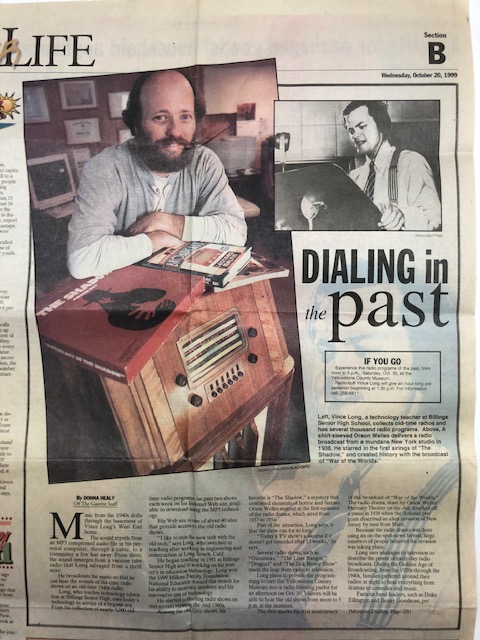 As part of the exhibition I did a talk on the opening day, October 30, 1999, appropriately the 61st-anniversary of the infamous "War of the Worlds" broadcast. I remember that the talk went well even though sparsely attended. In the lead up to the exhibition our local paper, the Billings Gazette, did a feature piece on me and my hobby that made the front page of the "Your Life" section on October 20, 1999. (While not being a publicity hound, I did make it into the paper 3 times in about 6-weeks that fall. A few weeks before the old time radio article I had received the Milken Educator Award and on November 10th I happened to be at a vegetarian potlock that the paper covered and one of my recipes, Hungarian Goulash with pinch dumplings, was featured.)
As part of the exhibition I did a talk on the opening day, October 30, 1999, appropriately the 61st-anniversary of the infamous "War of the Worlds" broadcast. I remember that the talk went well even though sparsely attended. In the lead up to the exhibition our local paper, the Billings Gazette, did a feature piece on me and my hobby that made the front page of the "Your Life" section on October 20, 1999. (While not being a publicity hound, I did make it into the paper 3 times in about 6-weeks that fall. A few weeks before the old time radio article I had received the Milken Educator Award and on November 10th I happened to be at a vegetarian potlock that the paper covered and one of my recipes, Hungarian Goulash with pinch dumplings, was featured.)
An elderly woman in Billings saw the old time radio piece and gave me a call in January 2000. She explained that she was down-sizing her living situation to get ready for a move to an assisted-living home and that her late-husband had recorded lots of radio shows and wanted to know if his tapes had any value. 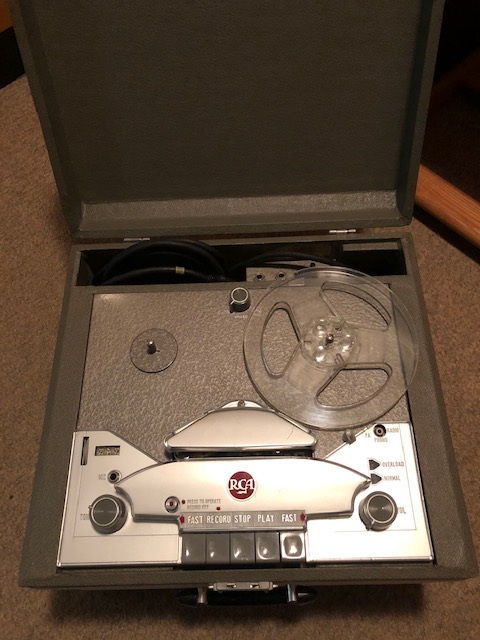 She added that her son had told her that all that "stuff" was going to the dump if he had to deal with it. I agreed to take a look at what she had and drove over to her house on a cold winter evening. She took me downstairs to her immaculately kept basement family room which was like getting into a time maching and landing in 1949. Radios, a TV, furniture, and everything else was straight out of that time and in excellent condition. She led me over to some shelving containing about 200 reels of tape. I read the labels on the spines of the boxes and was taken aback by what they potentially indicated: lots of big band remotes, news shows, sports, along with many family and local live recordings. I asked if she still had a recorder and she led me over to an RCA SRT-403. I fired it up and while the tubes were warming up I loaded a tape labeled "Arthur Godfrey" and presssed the "Play" button. Sure enough, out came the voice of Arthur Godfrey. This told me that, with a pretty high level of confidence, I could believe what the labels indicated. I told her that I could not really appraise this collection but I would make an offer, which I did. She was nonplussed and just said that she would have to check with her son. I told her to give me a call with their decision.
She added that her son had told her that all that "stuff" was going to the dump if he had to deal with it. I agreed to take a look at what she had and drove over to her house on a cold winter evening. She took me downstairs to her immaculately kept basement family room which was like getting into a time maching and landing in 1949. Radios, a TV, furniture, and everything else was straight out of that time and in excellent condition. She led me over to some shelving containing about 200 reels of tape. I read the labels on the spines of the boxes and was taken aback by what they potentially indicated: lots of big band remotes, news shows, sports, along with many family and local live recordings. I asked if she still had a recorder and she led me over to an RCA SRT-403. I fired it up and while the tubes were warming up I loaded a tape labeled "Arthur Godfrey" and presssed the "Play" button. Sure enough, out came the voice of Arthur Godfrey. This told me that, with a pretty high level of confidence, I could believe what the labels indicated. I told her that I could not really appraise this collection but I would make an offer, which I did. She was nonplussed and just said that she would have to check with her son. I told her to give me a call with their decision.
A day to so later she called and told me that my offer was accepted but I would also have to take the two tape machines for $50 each. Just wanting what might be on the tapes I readily agreed and set a time to come over and close the deal. 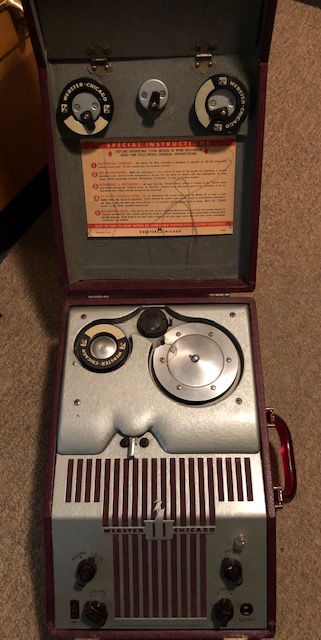 My son accompanied me and helped box up the tapes and haul them and the 2 tape machines out to the truck. One machine was the RCA SRT-403 and the other was in a wooden case. I hadn't really paid attention to what it was. As we were finishing up I mentioned to her that it was unusual for her husband to be into recording in the late-1940s as that technology was very new. She replied that he had been into it even before the war. I asked what he was recording on since I knew that tape had come after that time. She said she didn't know but that she still had that machine and she would just give it to me. Back down to the basement we went and she pointed to a brown case on a bottom shelf. I pulled it out and discovered that it was a Webster-Chicago Model 80 Wire Recorder in fine condition.
My son accompanied me and helped box up the tapes and haul them and the 2 tape machines out to the truck. One machine was the RCA SRT-403 and the other was in a wooden case. I hadn't really paid attention to what it was. As we were finishing up I mentioned to her that it was unusual for her husband to be into recording in the late-1940s as that technology was very new. She replied that he had been into it even before the war. I asked what he was recording on since I knew that tape had come after that time. She said she didn't know but that she still had that machine and she would just give it to me. Back down to the basement we went and she pointed to a brown case on a bottom shelf. I pulled it out and discovered that it was a Webster-Chicago Model 80 Wire Recorder in fine condition.
During the course of our conversations she asked what I would do with all these recordings and I told her I planned to transfer them to my computer and share them with the old time radio community through my web site. Knowing that some of the recording were family-related, I told that I would make CDs of those for her family and would not be releasing them to the public. I thanked her and we were on our way.
It wasn't until I got home and unloaded everything that I realized what was in the wooden box. I did a quick lookup online to verify it and saw that the Brush BK-401 was one of the first, if not THE first, tape recorder on the consumer market. What even made this find better is that, not only is it in very fine condition, it is complete with the take up reeel, reel hold-down clips, owner's manual, and microphone. Add to that: it works.
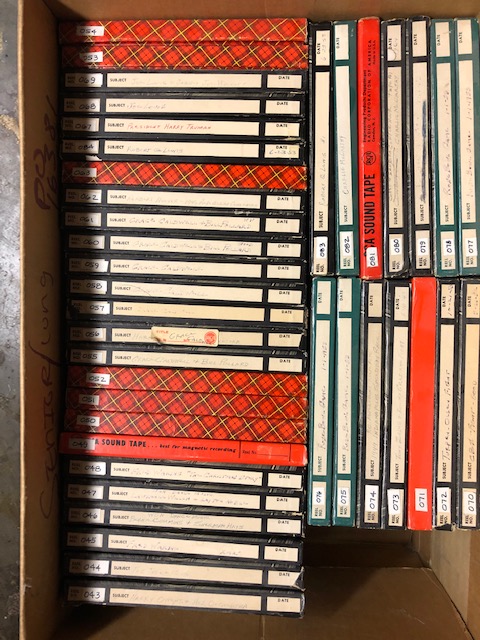 While not planning on using this machine, I do keep it proudly on display in my home. The tapes were another story. I sorted the reels into two stacks, the family recordings in one and the broadcast recordings in the other. I started with the family recordings and, using my Akai GX-260D, I transferred all of those to my computer where I did some light editing before burning a couple sets of CDs which I gave back to the family. These were interesting as they included birthday parties, get-togethers, and even the original recordist interviewing his mother who had come to Montana in, I think, the late-1800s. There were also many live, non-family recordings made at Shriner events in the late-1940s. Perhaps, at some point, the non-family recordings could be released.
While not planning on using this machine, I do keep it proudly on display in my home. The tapes were another story. I sorted the reels into two stacks, the family recordings in one and the broadcast recordings in the other. I started with the family recordings and, using my Akai GX-260D, I transferred all of those to my computer where I did some light editing before burning a couple sets of CDs which I gave back to the family. These were interesting as they included birthday parties, get-togethers, and even the original recordist interviewing his mother who had come to Montana in, I think, the late-1800s. There were also many live, non-family recordings made at Shriner events in the late-1940s. Perhaps, at some point, the non-family recordings could be released.
After working my way through that batch of tapes I started on the rest and these became the Paper Tape Archive which went live in May of 2003. These were made off-the-air and covered sports, news, religion, and the big bands. Click that link to see and listen to the collection.
In the meantime, the Brush BK-401 Soundmirror has found a good home.
Epilogue: The woman from who I got the tapes did move to a retirement home and lived to be 101 years old, passing away just a few years ago.
The Brush BK-401 Operators Manual in PDF |
I found this tucked inside the Operators Manual. It is a page from Better Homes and Garden, September 1965 |
Boxes and Reels of Paper Tapes | ||
 |
 |
 |
 |
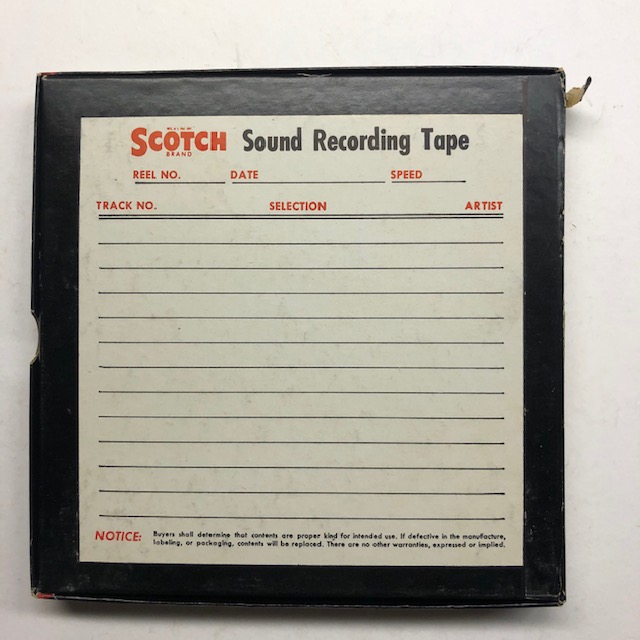 |
 |
 |
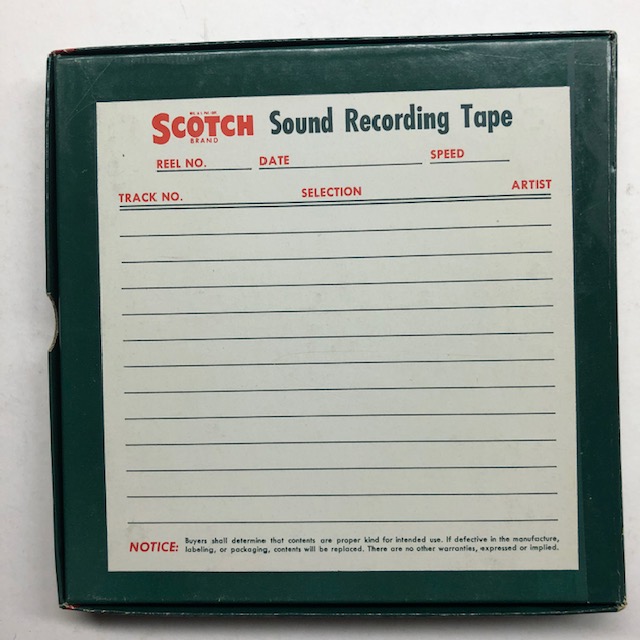 |
 |
Click on an image to enlarge it.
Updated November 2020.